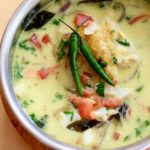Veena Prasad:
Project Feast founder
and executive director, 2013-2019
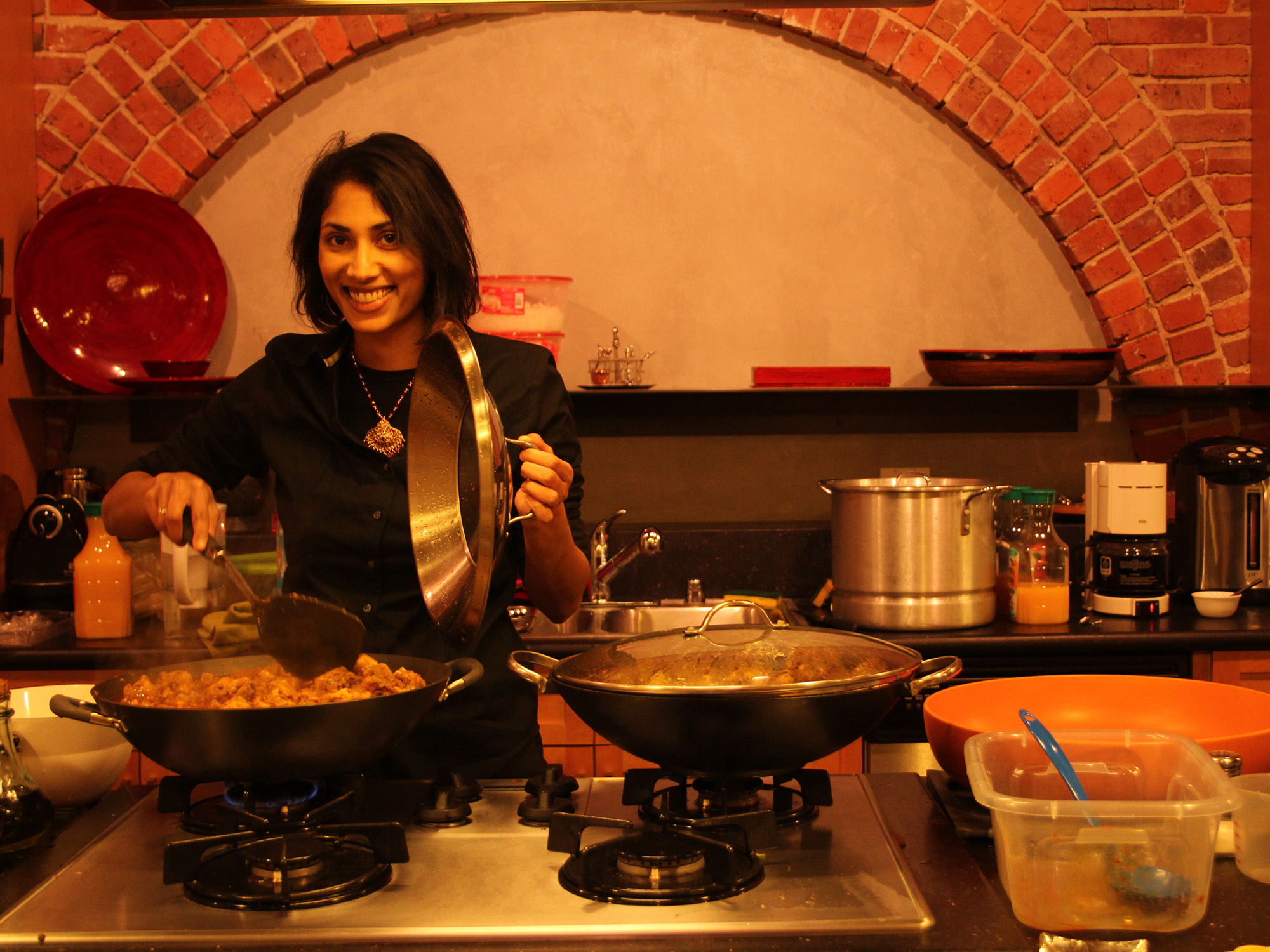
“Food is a way to remember.”
Founder Veena Prasad reflects on the relationship of food and community, what it’s like to start a nonprofit – and how she treasures food and people from all over the world because of Project Feast.
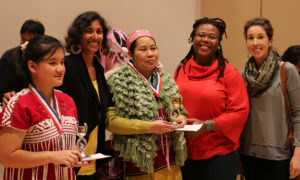
In the early years, Project Feast collaborated frequently with the Seattle area Burmese community. Annie Philit, in the middle of this photo next to Veena, worked with Project Feast on several events.
When Seattle entrepreneur Veena Prasad decided her next venture would be a startup nonprofit, she didn’t imagine that the challenges ahead would include opening a restaurant. Or that she would arrive home many nights in the wee hours after a catering event, hair and clothes infused with the scent of raw chopped onions.
But from the beginning, Veena knew the purpose for the startup she named Project Feast: Empower immigrant and refugee cooks to find good food jobs through training that celebrates their experiences. Since 2013, when Veena launched Project Feast with a bit of her own money and a small, motivated group of volunteers, the nonprofit has grown to train dozens of immigrants and refugees – many moving on to jobs in the Seattle area or opening their own businesses. And these cooks also have left a lasting impact on Veena. “It’s such a gift, talking with people from around the world, learning about their day-to-day lives, sharing their food,” she says.
Two years after leaving Project Feast to focus on her family, Veena reflects on what it’s like to start a nonprofit, why it’s important to let go – and how she knows and loves food and people from around the world because of the experience.
How did you begin exploring the importance of food in immigrants’ experiences?
Veena: “I’d come from the corporate sector before starting my business, Veena’s Market, which was about helping people cook Indian food at home. I started with Indian because of my familiarity from growing up in South India. It was so interesting to make recipes into an experience and product people could buy. Indian food is fairly well-known, but people often don’t recognize it’s not just one cuisine. India holds many cultures and many cuisines.
It made me think about the food we eat and what it says about us and our cultures. As an adult, I was missing India a lot. Food is a way to remember. It became clear to me: You don’t just leave a country and become a new person. You’ve got to feed all parts of your identity. It took starting a food business for me to understand that.”
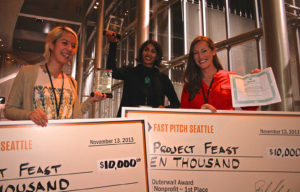
Social Venture Partners Fast Pitch competition, 2013.
What was the spark to start Project Feast?
Veena: ”I loved being an entrepreneur, but I felt like there was something missing. I wanted my work to be about something bigger. Around the same time, I learned more about the challenges of immigration. I knew my own experience, but I had a lot of mistaken notions about other people’s experiences of immigration. And it was a whole other world learning about how refugees come to the United States and the challenges they face.
I knew how important food was for me and my community. When you’ve had this big change, you want to hold on to something familiar. Then, I learned about the Social Ventures Partners pitch competition and decided to try it. It was a very early idea. I kept working on it and pulling other people in to help.”
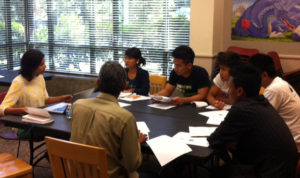
Veena, left, leads a food-safety workshop in August 2013.
At first, Project Feast focused on training for food-handler’s permits. How did you start to grow?
Veena: “The food-handler training was easier than an intensive program, but the workshops never felt like enough. A year in, we had the opportunity to get support from the Tukwila Community Center. Our program went from a few hours to six weeks. It was always a small group – five or six people – but they inevitably came from different cultures and it was really special seeing those interactions. Everyone shared their foods. The common theme we heard was, ‘We want to learn more.’ People wanted an experience like cooking school. They wanted to be able to start a business or get a job. It was important to take things a level up, and that would require our own space.”
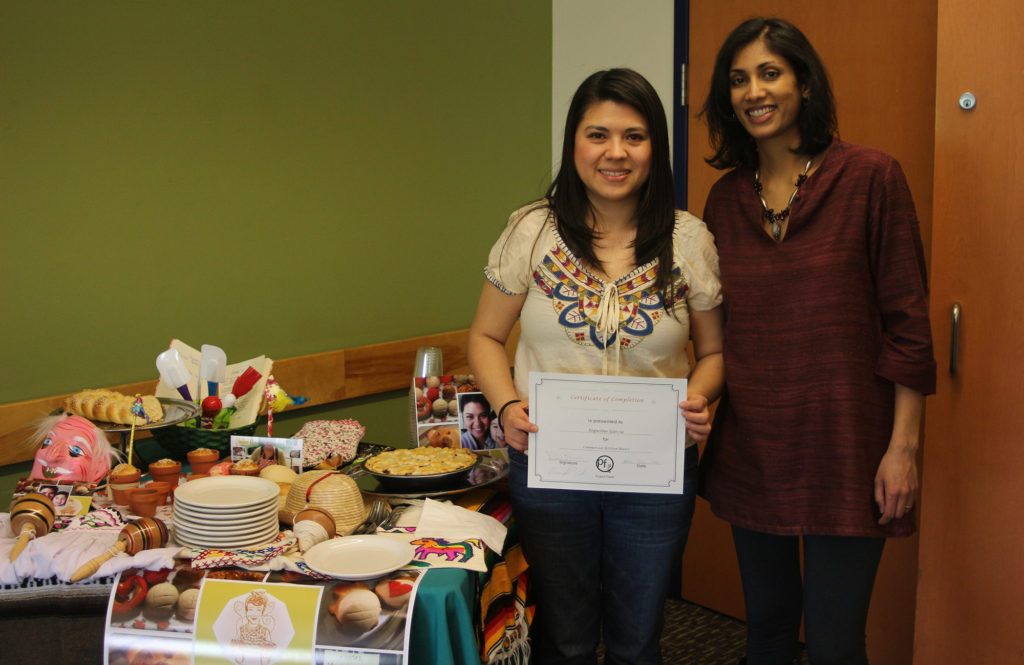
Jacqueline Garcia’s graduation in 2014. Jacqueline would go on to become a member of the Project Feast Board of Directors.
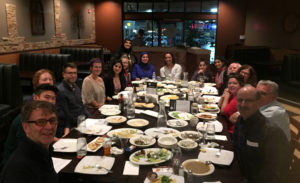
An early Migrating Meals dinner at the Olive Tree Restaurant in Kent.
What was this transition period like?
Veena: “There was a year when we didn’t have our own kitchen and we were struggling to find a commercial kitchen. At the same time, Trump was running for president, and then won. So, the combination of not having a space and seeing anti-immigrant and anti-refugee rhetoric in the political process was quite disturbing. Molly Payne [program coordinator at the time] had a brilliant idea to create a series of events to take people to restaurants owned or run by refugees or immigrants. We wanted to focus on the joy immigrants bring to this country. For those who hadn’t known about these restaurants, it was a way to expand their horizons and get to know more about Project Feast. We called it ‘Migrating Meals.’
The first event was at Safari Njema, a Kenyan restaurant in Columbia City. It’s run by Jane Kagira. She has the most brilliantly big smile. She has a big personality. We had a big group. We got to celebrate this powerful woman, chef and restaurant owner and eat her food. One of the questions that came up was: ‘Because Kenya is a former British colony, what were some of the influences the British have brought to the Kenyan cuisine?’ That turned to a discussion of the impacts of colonization. It felt so freeing to talk about these issues. It was amazing conversation.”
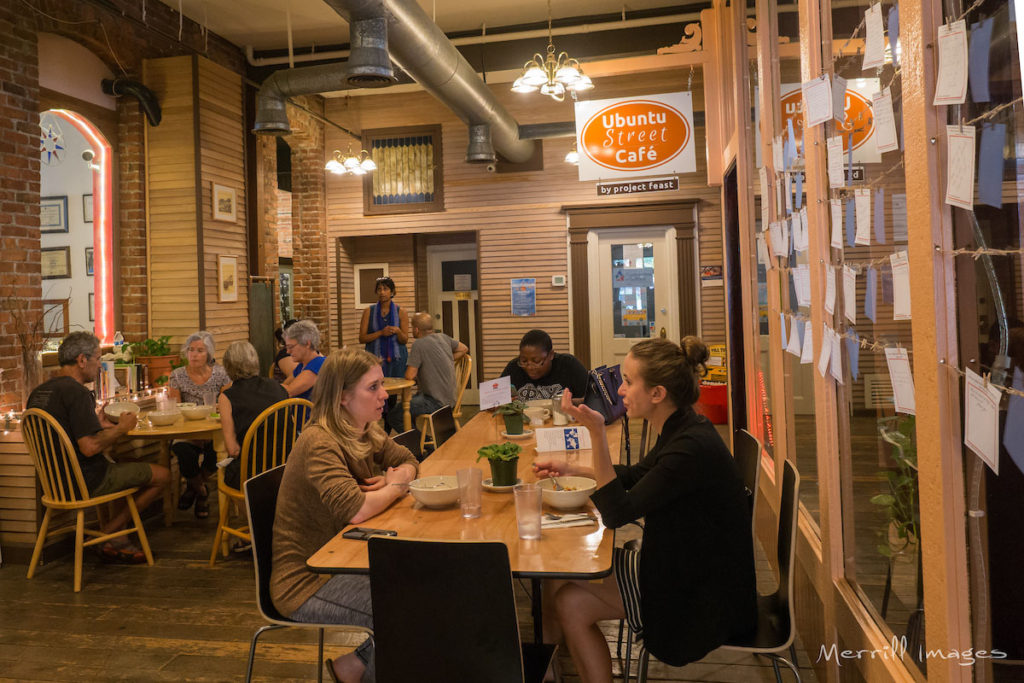
Ubuntu Street Cafe, 2017. (Merrill Images)
When the apprenticeship launched in 2017, it also included the café. How hard was that to pull together?
Veena: “It was a huge undertaking to bring in commercial kitchen equipment in the budget that we could pull together with the help of partners. The blood, sweat and tears that went into opening the restaurant! But then calling it Ubuntu Street Cafe was just the icing on the cake. I think it turned out to be this sweet spot. And hopefully helped bring some excitement to that part of downtown Kent. I feel proud to have been part of this whole Project Feast story – and within that, to have opened a restaurant.”
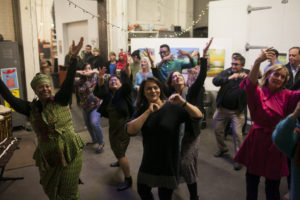
Dancing at the annual Feast for Change fundraiser, 2018.
What was one challenge of creating a full apprenticeship program?
Veena: “We had a hard time finding curricula made for the immigrant community. We didn’t want curriculum wrapped around Italian and American staples. We wanted apprentices’ food and their particular barriers of language and access to be addressed. So, we were forced to develop a lot of the curriculum ourselves. But I’m glad we stuck to that. It’s important to focus on the skills people have and what they bring with them.”
Why was 2019 the right time for you to step away?
Veena: “A lot of things came together and made me reflect on what I wanted. We were deciding whether to enroll my twins in kindergarten and around the same time, I learned of a terminal illness in my family. I had also been feeling burnt out for a while. It was a big moment and I realized that I wanted to spend more time with my kids – they were growing up so fast! I had both a really young organization, which took a lot of creative thinking and problem solving, and twin babies and all the joys and sleepless nights that came with that. I had to be honest and realize it’s OK to step away. An organization should last beyond the founder’s vision for it. If you can make that happen, and it’s the right time for the organization, that’s the healthiest thing you can do as a founder.
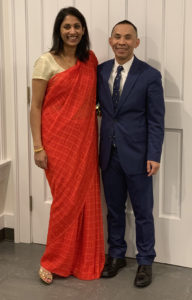
Veena with Wesley Nguyen, Project Feast Board president, 2019.
It took time to feel ready to let go, and I made my peace with it. I’m really happy. It was the right thing to do. The biggest leadership lesson was the letting go part, and I’m definitely a better leader for going through that whole cycle.”
How worried were you for Project Feast when the pandemic struck in 2020?
Veena: “I was definitely worried, but I had let go, so all I could do was be supportive from the outside. I had a lot of respect for [current executive director] Van Nguyen going through this. She was just six months into taking over Project Feast, but she was calm and collected throughout. She and the team pivoted. They had to. And I love the direction they’ve taken. I’m also delighted to support in a tiny way by being the West Seattle hub for the family meals.”
What are some of your lasting food memories?
Veena: “There are so many! In those early catering days, I worked one-on-one with many folks – including Chato Carver, Taghreed Mahmood, Rehab Babiker, the sisters Zozan and Sheelan Shamdeen and others – and I learned a lot of their food. I loved how much thought they put into creating a big, fabulous spread. I learned so much about what generosity and hospitality mean. Of course, I remember the food as well. I love maqluba. I love anything with eggplant in it. All the various kinds of kibbeh! I love it. Cooking with people, learning their food and that interaction was so special. And I definitely miss that.”
What stays with you as you look back on this experience?
Veena: “I started with this notion of wanting to help – wanting to help build something, to help people and impact their lives. But through this experience, I’ve actually received so much myself. I’ve had so many wonderful examples of compassion and grace. Despite all kinds of circumstances, people are so resilient – and I found that same resilience in myself. I’ve learned so much about all kinds of things I never conceived of when I started this journey. And that’s been very, very meaningful to me.”
– Interview lightly edited for length. Interview and writing by Denise Clifton, Tandemvines Media
Roasted Okra
Ingredients
- 2 lbs. okra rinsed and ends cut
- 1/3 cup oil
- 1 tsp sea salt
- 4 tsp garam masala*
Instructions
- 1. Preheat oven to 450 degrees F.
- 2. Cut the okra in half lengthwise and pat dry.
- 3. Toss with oil, salt and garam masala.
- 4. Place in a single layer on a tray.
- 5. Broil for 4 to 5 minutes on each side.
- Serves 4 to 6 as an appetizer.
- *Garam masala is available in most grocery stores.
Garden Saag Paneer
Ingredients
- 1 small yellow onion
- 10 oz fresh greens*
- 1/2 lb paneer** (Appel Farms paneer is available in Whole Foods and PCC)
- 1 tsp cumin seeds
- 2 cloves garlic, minced
- 1 -inch piece of ginger, peeled and grated
- 2 tsp garam masala, North Indian spice blend
- 1/2 tsp turmeric
- 1/4 tsp red chili powder
- 1/2 cup plain yogurt or cream, optional
- 1 tbsp + 3 tbsp vegetable oil
- ~ 1 tsp salt or to taste
Instructions
- 1. Rinse and pat dry the spinach and thinly slice the onion.
- 2. Dice the paneer into 1-inch cubes.
- 3. Heat 1 tbsp oil in a large saucepan or wok over medium heat.
- 4. When you see a shimmer on the surface of the oil, add the paneer. Sear until the paneer is slightly browned, about 3 minutes. Remove and set aside.
- 5. Add 3 tbsp oil to the pan. Check to see if the oil is hot enough by throwing in a cumin seed. If it sizzles, the oil is ready. Add the rest of the cumin and allow it to sizzle till you smell the aroma, about 10 seconds.
- 6. Sauté the onion with ½ tsp salt for 2 minutes or till onion is soft and translucent.
- 7. Add the ginger and garlic and sauté for another 3 minutes or till the onion is just slightly brown.
- 8. Add the remaining spices and fold in the spinach. Sauté till the leaves have wilted. Turn off the heat and let sit for 5 to 10 minutes to cool down.
- 9. Puree the sautéed spinach and onion in a blender or food processor with ¼ cup of water. Once blended, pour back into the pan along with the paneer and ¼ cup water.
- 10. Bring to a gentle boil over medium heat and turn heat to low. Add yogurt and simmer the curry for 5 minutes. The yogurt is optional but adds a creamy smoothness to the dish.
- 11. Add salt to taste and serve with warm naan (available in most grocery stores), flour tortillas or rice
- Serves 4 to 6 as an entree.
- * I love using a mix of greens like spinach, chard, and mizuna from the garden. For convenience, you can use the 10 oz container of spinach leaves available in many grocery stores.
- ** You can substitute hard-boiled eggs sliced in half lengthwise or chicken cut in 1-inch cubes. If using chicken, simmer the curry for 15 minutes or till chicken is cooked.
Meen Moily
Ingredients
- 2 lbs white fish – rockfish, tilapia and halibut all work well – cut into 3-inch chunks
- 1 tsp turmeric powder
- 2 tsp lemon or lime juice
- 4 tbsp coconut oil (You can substitute with any vegetable oil)
- 1 stick cinnamon, broken into roughly 1-inch pieces
- 1 tsp black mustard seeds (optional)
- 10 to 15 curry leaves*
- 1- inch piece of ginger, minced
- 2 to 3 long green chilis or jalapeños, sliced (optionally remove seeds to reduce the heat)
- 1 medium red onion, thinly sliced
- 1 15 oz can coconut milk
- 2 tsp salt or to taste
- 1 medium tomato (any kind), medium diced
- 3 to 4 stalks cilantro, thick stalk ends removed and finely chopped
- ½ tsp ground black pepper (optional, ideally freshly ground)
- ¼ tsp ground cardamom (optional, ideally freshly ground)
Instructions
- 1. Marinate the fish with turmeric and the lemon or lime juice.
- 2. Heat the coconut oil in a large wok or fry pan over medium to medium high heat. You need to get the oil to just the right temperature. You’ll see ripples on the surface of the oil as it gets hot enough. You know the oil is ready if you throw in a slice of onion and it sizzles.
- 3. Sizzle the cinnamon, mustard seeds and curry leaves for 10 seconds or till the mustard seeds “pop”. Watch out for the splatter!
- 4. Add the chilies, ginger and red onion next and saute for 2 to 3 minutes, stirring regularly, until the onion starts browning.
- 5. Add the fish and reduce the heat to medium-low. Saute for another 2 to 3 minutes. Stir gently so as to not break the fish apart too much.
- 6. Add coconut milk, salt and tomatoes. Cook for another 5 minutes or till the fish is done.
- 7. Sprinkle the ground spices over the stew and garnish with tomato and serve immediately.
- Serve this dish with basmati or jasmine rice.
- Serves 4 to 6 as an entrée.
- *It is well worth the effort to buy fresh curry leaves – the only required specialty ingredient in this recipe. They’re used in most South Indian cooking and can also be easily dried and stored for later use. All Indian stores will carry curry leaves. I often find them in Asian stores, especially Vietnamese stores. You can also buy them online!
Gadbad Ice Cream
Ingredients
- 2 to 3 flavors of ice cream (We like vanilla, strawberry and mango)
- 3 to 4 kinds of fruits, chopped (We like apple, banana, red seedless grapes, pineapple, and mango)
- Strawberry jelly made ahead of time (Optional)
- 2 to 3 kinds of unsalted nuts, chopped (Optional. Cashews, pistachios, almonds)
- Cherries or mango puree for garnish
Instructions
- 1. In tall glasses, layer the ingredients starting with a scoop of vanilla ice cream, then adding a couple tablespoons of fruits.
- 2. Next, add a scoop of strawberry ice cream followed by more fruits or nuts.
- 3. Last, add a layer of jelly and top off with a scoop of vanilla or the third flavor of ice cream.
- 4. My family likes a drizzle of mango purée, but cherries make a gorgeous garnish too.

